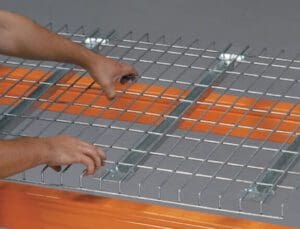
Advanced Handling & Storage Ltd
The Pallet Racking People

When it comes to keeping your warehouse merchandise safe, you can’t afford to cut corners. Every precaution from high-powered security systems to regular safety checks is used to safeguard your valuables against harm. That’s because each product is a piece of the revenue stream that keeps your business afloat. So what happens when the occasional stray product migrates from its box or when threat of fire sets off your sprinklers, leaving water to pool on your solid shelving units? If your warehouse is outfitted with OSHA-recommended wire decking, you’re more likely to be covered.
The utility wire decks add to your storage capabilities have a host of benefits including their ability to provide further stability for your stored pallets, especially for split or open cases. And while the different types mean there’s at least one that’s sure to be a fit for any kind of facility, it can be difficult to know which is best suited for your needs.
Here we’ll uncover more about the benefits of wire mesh decks, and distinguish the main types of decks to help you decide which is right for your warehouse.
Why is Wire Mesh Decking Important For My Warehouse?
Safety is always the number one priority in any warehouse environment. Not just safety of the employees but also of the products themselves. When you install wire mesh decking to your pallet racks you’re adding a tried and true layer of defence against products slipping past your racking system and causing workplace injury or damage to your material handling equipment. Thanks to their thinly spaced design they also have built in mechanisms that can prevent dust build up on your products and allow water to pass through them in the event of a fire.
In addition to their invaluable safety features, wire mesh decks also make order fulfilment easier since employees have a clear line of site to each product and increase the sturdiness of your racks by equally distributing weight across its beams.

What Are the Different Types of Wire Mesh Decks?
In total there are a few common types of wire decking. The specifics of your layout and kinds of products stored in the warehouse will determine which type of wire deck your pallet racking system will benefit from.
There are two overarching categories of wire mesh decks which are waterfall wire mesh deck sand flared wire decks.
Flared wire decking, the most popular style, has welded channels that fasten to the ledge of each step-beam.
Waterfall wire decks fix into place by cascading over the front and back of the beam whereas drop-ins sit flush with the beams.
Standard – The support channels on the beam steps and the waterfall wraps over the top of the beam.
Drop-in/Flush – Straight wires are hidden and fit snuggly similar to the step style, but without the waterfall feature that wraps around the rack beam.
Flared Channel – The universal features of this type includes a flared flange at either end that allows decks to be used with box or step beams. Similar to step style, a waterfall wraps around the beam.
Inverted Channel – With upside down support channels this type of wire deck is notoriously great at preventing debris accumulation and is commonly used in warehouses that store food products and other sensitive materials.
Inside, Outside & Upturned Waterfall – Inside waterfall decks sit exposed within step beams, shifting load weights toward the inner step. Outside wire decks do the same, but with hidden wires. With upturned waterfall decks the wires are bent upward to help secure your load.
Ultimately, there’s a reason wire mesh decks are a recommended standard when it comes to warehouse safety. Don’t overlook these inexpensive inventory securities next time you’re making adjustments to your new or existing warehouse design. It could mean the difference between an injury-free year and devastating revenue loss.

Get in Touch with Advanced Handling & Storage
If you want to maximise your warehouse space through the use of second hand or new mesh decking, then please don’t hesitate to get in touch with us on 0800 345 7088 or send an email to [email protected]
Make sure you follow #TeamAdvanced on Social media for all our latest news and offers.
Like us on Facebook
Follow us on Twitter
Connect with us on LinkedIn
Subscribe to Our YouTube channel
Follow us on GooglePlus
Read our other blogs on Medium
Follow us on Instagram